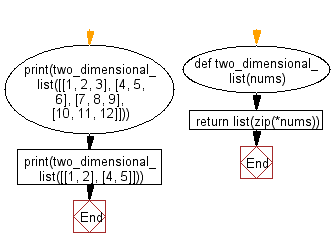Python: Create a two-dimensional list from given list of lists
Convert List of Lists to 2D List
Write a Python program to create a two-dimensional list from a given list of lists.
- Use *nums to get the provided list as tuples.
- Use zip() in combination with list() to create the transpose of the given two-dimensional list.
Sample Solution:
Python Code:
# Define a function named 'two_dimensional_list' that takes a list of lists as input.
def two_dimensional_list(nums):
# Use the 'zip' function to transpose the given two-dimensional list.
return list(zip(*nums))
# The '*' operator is used to unpack the sublists as separate arguments to 'zip.'
# Test the 'two_dimensional_list' function with different two-dimensional lists.
print(two_dimensional_list([[1, 2, 3], [4, 5, 6], [7, 8, 9], [10, 11, 12]]))
# Transpose a 4x3 matrix. (Expected output: [(1, 4, 7, 10), (2, 5, 8, 11), (3, 6, 9, 12)])
print(two_dimensional_list([[1, 2], [4, 5]]))
# Transpose a 2x2 matrix. (Expected output: [(1, 4), (2, 5)])
Sample Output:
[(1, 4, 7, 10), (2, 5, 8, 11), (3, 6, 9, 12)] [(1, 4), (2, 5)]
Flowchart:

For more Practice: Solve these Related Problems:
- Write a Python program to convert a flat list into a 2D list given the number of columns.
- Write a Python program to transpose a 2D list (matrix) obtained from a list of lists.
- Write a Python program to convert a list of tuples into a 2D list with each tuple representing a row.
- Write a Python program to group every k elements of a flat list into a 2D list.
Previous: Write a Python program to move the specified number of elements to the start of the given list.
Next: Write a Python program to generate a list, containing the Fibonacci sequence, up until the nth term.
Python Code Editor:
What is the difficulty level of this exercise?
Test your Programming skills with w3resource's quiz.
